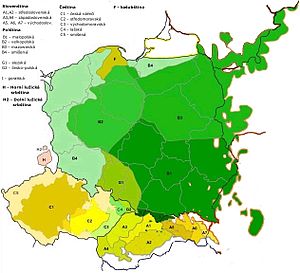West Slavic languages
| West Slavic | |
|---|---|
| West Slavonic | |
| Geographic distribution | Central Europe |
| Linguistic classification | Indo-European
|
Early forms | |
| Subdivisions | |
| ISO 639-5 | zlw |
| Glottolog | west2792 |
 Distribution of the West Slavic languages and dialects. | |

TheWest Slavic languagesare a subdivision of theSlavic language group.[1]They includePolish,Czech,Slovak,Kashubian,Silesian,Upper SorbianandLower Sorbian.[1]The languages have traditionally been spoken across a mostly continuous region encompassing theCzech Republic,Slovakia,Poland,[1]the westernmost regions ofUkraineandBelarus,and a bit of easternLithuania.[citation needed]In addition, there are severallanguage islandssuch as the Sorbian areas inLusatiainGermany,[1]and Slovak areas inHungaryand elsewhere.[2]
Classification[edit]
West Slavic is usually divided into three subgroups—Czech–Slovak,LechiticandSorbian—based on similarity and degree ofmutual intelligibility.The groupings are as follows:[3]
| West Slavic | |
TheMax Planck Institute for Evolutionary Anthropologyclassifies the West Slavic languages within theirGlottologdatabase as follows:[4]
| West Slavic | |
Some linguists include Upper and Lower Sorbian in the Lechitic branch, but other linguists regard it as a separate branch.[5]The reason for this is that 'the Sorbian dialects are extremely diverse, and there are virtually no linguistic features common to all Sorbian dialects which distinguish them as a group from the other Slavic languages' (Sussex & Cubberley 2006).[5]Czech and Slovak are more closely related to each other than to the other West Slavic languages, and also closer to each other than Polish and Sorbian are.[5]Czecho-Slovak (Slovak in particular) shares certain features with other Slavic languages, such asSloveneandBCMS.[5]
Distinctive features[edit]
Some distinctive features of the West Slavic languages, as from when they split from theEast SlavicandSouth Slavicbranches around the 3rd to 6th centuries AD (alternatively, between the 6th and 10th centuries[6]), are as follows:[7]
- Development ofProto-Slavic*tj,*djinto palatalizedts,(d)z,as in modern Polish/Czech/Slovaknoc( "night"; compare Russianночь);
- Retention of the groupskv,gvas in Polishkwiat( "flower" );gwiazda( "star" ) (Compare Russianцвет(cvet);звезда(zvezda));
- Retention oftl,dl,as in Polish/Slovak/Czechradło/radlo/rádlo( "ard";compare Russianрало);
- Palatizedhdeveloped intoš,as in Polishmusze(locativecase ofmucha,"fly" );
- The groupspj,bj,mj,vjdeveloped into (soft) consonant forms without theepenthesisofl,as in Polishkupię( "I shall buy"; compare Russianкуплю);
- A tendency towardsfixed stress(on the first syllable in Czech and Slovak and on the penultimate syllable in Polish);
- Use of the endings-egoor-éhofor the genitive singular of the adjectival declension;
- Use of the pronoun form*tъnъrather than*tъ,leading to Slovak/Polish/Czechten( "this" (masc.); compare Russianтот;Old Church Slavonicтъ);
- Extension of the genitive form*čьsoto nominative and accusative in place ofčь(to),leading to Polish/Czechco( "what", compare Russianчто;OCSчьто,genitive чьсо).
Although influences from other language families have contributed a lot ofloanwords,and to a lesser extent to verbmorphologyand syntax, the Slavic languages retained a distinctly Slavic character, with clear roots in Indo-European.[6]
The West Slavic languages are all written in theLatin script,while the East Slavic branch uses Cyrillic[8]and the South Slavic branch is mixed.[6][9][10]
History[edit]
Theearly Slavic expansionreached Central Europe in c. the 7th century, and the West Slavic dialects diverged from Common Slavic over the following centuries. West Slavic polities of the 9th century include thePrincipality of NitraandGreat Moravia.The West Slavic tribes settled on the eastern fringes of theCarolingian Empire,along theLimes Saxoniae.TheObotriteswere given territories byCharlemagnein exchange for their support in his war against theSaxons.[citation needed]
In the high medieval period, the West Slavic tribes were again pushed to the east by the incipient GermanOstsiedlung,decisively so following theWendish Crusadein the 11th century. The Sorbs and otherPolabian SlavslikeObodritesandVeleticame under the domination of theHoly Roman Empireand were stronglyGermanized.[11]
The Bohemians established theDuchy of Bohemiain the 9th century, which was incorporated into the Holy Roman Empire in the early 11th century. At the end of the 12th century the duchy was raised to the status ofkingdom,which was legally recognized in 1212 in theGolden Bull of Sicily.Lusatia,the homeland of the remaining Sorbs, became acrown landof Bohemia in the 11th century, and Silesia followed suit in 1335. TheSlovaks,on the other hand, never became part of the Holy Roman Empire, being incorporated into theKingdom of Hungary.Hungary fell underHabsburg rulealongside Austria and Bohemia in the 16th century, thus uniting the Bohemians, Moravians, Slovaks, and Silesians under a single ruler. While Lusatia was lost toSaxonyin 1635 and most of Silesia was lost toPrussiain 1740, the remaining West Slavic Habsburg dominions remained part of theAustrian Empireand thenAustria-Hungary,and after that remained united until 1992 in the form ofCzechoslovakia.[citation needed]
Over the past century, there have been efforts by some to standardize and to recognizeSilesian,Lachian,andMoravianasseparate languages.[citation needed]
See also[edit]
- West Slavs– Subgroup of Slavic peoples
- Comparison of Czech and Slovak
- Outline of Slavic history and culture
Notes[edit]
- ^Knaanicis classified as a dialect of Czech under the name "West Judeo-Slavic".
- ^Slovincianis classified as a dialect of Kashubian.
References[edit]
- ^abcd"Slavische talen".EncartaEncyclopedieWinkler Prins(in Dutch). Microsoft Corporation/Het Spectrum. 1993–2002.
- ^"Slowaakse taal".Encarta Encyclopedie Winkler Prins(in Dutch). Microsoft Corporation/Het Spectrum. 1993–2002.
- ^Blažek, Václav."On the internal classification of Indo-European languages: Survey"(PDF).pp. 16–17.
- ^Hammarström, Harald;Forkel, Robert;Haspelmath, Martin;Bank, Sebastian (2023-07-10)."Glottolog 4.8 - West Slavic".Glottolog.Leipzig:Max Planck Institute for Evolutionary Anthropology.doi:10.5281/zenodo.7398962.Archivedfrom the original on 2023-09-07.Retrieved2023-09-06.
- ^abcdSussex & Cubberley 2006,p. 55.
- ^abcSussex & Cubberley 2006,p. 58.
- ^Zenon Klemensiewicz,Historia języka Polskiego,7th edition, Wydawnictwo naukowe PWN, Warsaw 1999.ISBN83-01-12760-0
- ^Sussex & Cubberley 2006,p. 60.
- ^O.T. Ford."Slavs".the-stewardship.org.The Stewardship.Retrieved2022-01-27.
- ^Zivanovic, Maja (2 August 2018)."Serbia Proposes Law Changes to Halt Cyrillic's Decline".Balkan Insight.Retrieved28 November2018.
- ^Christiansen, Erik (1997). The Northern Crusades. London: Penguin Books. p. 287.ISBN0-14-026653-4.
Bibliography[edit]
- Sussex, Roland; Cubberley, Paul (2006).The Slavic Languages.Cambridge University Press.ISBN9780521223157.
